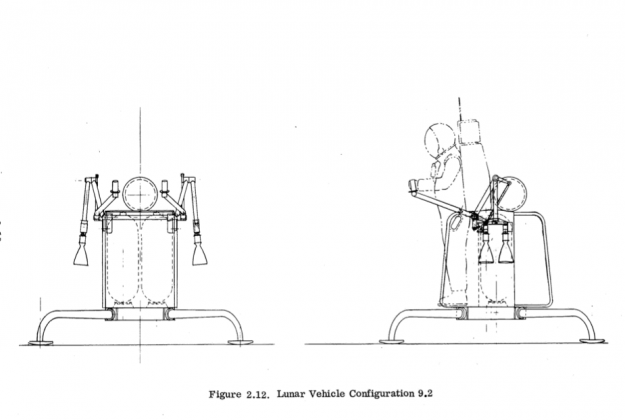Flying single Apollo mission vehicle on the moon: the story of one project

This is how the first managed rover of the Apollo 15 mission looked. And a jet engine might have
From the very beginning of the “lunar project”, NASA had planned several stages of the moon’s exploration by man, so to speak. The first stage is just a round-trip flight of a spacecraft with a man on board. To check the technical possibility of such a journey.
Then, subject to the successful completion of the first stage, scientific expeditions were already planned, with a man landing on the Moon's surface, and a subsequent survey of the landing region. Of course, it would have been a bit tangible to go through the legs, so the use of the vehicle was planned from the very beginning of the project.
')
NASA tried to envisage a lot, and therefore several variants of rovers were designed simultaneously in parallel. At the same time, third-party organizations were involved, for example, Bell Aerosystems. It was this company that created the project of a flying lunar rover with a jet engine (by itself, not the most powerful, otherwise it would be possible to fly away in an unknown direction).
Early Moon Vehicle Concepts
From the very beginning, some experts proposed to create a platform for one person, with a reactive principle of movement (the engine would work on compressed air). The key point of the whole system should have been balance: it would not be very good if in the very first test flight on such a vehicle an astronaut would fly upside down.
In general, all this has been developed since 1951, and projects of various types (not only flying vehicles) have been offered quite often. So, engineers from Marshall Flight Center offered a mobile lab, known as MOLAB, in 1964.
In addition, Ford engineers offered NASA once a whole range of wormlike rovers. True, these rovers would be ideal for long work on the moon, and not for one-time work. Therefore, the project failed.
Well, for medium-length missions, Bell Aerosystems was offered a flying device, which was discussed above. It was a minimalistic device, which, in short, was excellent for covering large distances with minimal resources.
 By the way, at first it was assumed that the astronaut would be in a sitting position, but then it was decided that it would be best to create a “standing” vehicle. The resource of such a device is 30 flights, with a total distance (on all routes in general) of 20-30 kilometers. The balance, as mentioned above, was supposed to be perfect, and the astronaut could control the movement of the apparatus in all axes.
By the way, at first it was assumed that the astronaut would be in a sitting position, but then it was decided that it would be best to create a “standing” vehicle. The resource of such a device is 30 flights, with a total distance (on all routes in general) of 20-30 kilometers. The balance, as mentioned above, was supposed to be perfect, and the astronaut could control the movement of the apparatus in all axes.
This is how the researchers of the Moon could soar if the project of the flying apparatus would have passed.
The flying vehicle was also good because in the event of unforeseen circumstances the astronauts could quickly return to the landing module.
The final version of the project of the flying module was assessed as very reliable, its reliability was estimated as “three nine”, according to the NASA scale. This is a very high score, indicating that 99.9% of the total operating time of the device works perfectly.
At the same time, the device was developed taking into account the fact that people in uncomfortable space suits with thick gloves on their hands will assemble it. Among other things, the device had to be folded so that during transport it occupies the minimum amount of spacecraft.
Everything seemed to be perfect, and after the Apollo 11 expedition, experts confirmed that the flying vehicle is ideal for lunar conditions.
Rovers, not "flyers"
But things did not go as planned. The fact is that three months before the completion of the research Bell Aerosystems (the project was proposed by the company on April 7, 1969), Werner von Braun established a team to design a rover. Von Braun believed that the rover, a more traditional vehicle model, is better suited to the moon than a flying device.
And almost immediately after the start of work on the design of the rover, a contract was signed with Boeing to create such a device. As is known, the first of three lunar rovers reached the moon with Apollo 15 in 1971. Field tests showed that the rover is a successful project, and this concept was used in the future.
So, unfortunately, the astronauts could not fly alone on the moon. And it would be interesting, the history of lunar explorations could be a bit different.
Via dvice
Source: https://habr.com/ru/post/229383/
All Articles